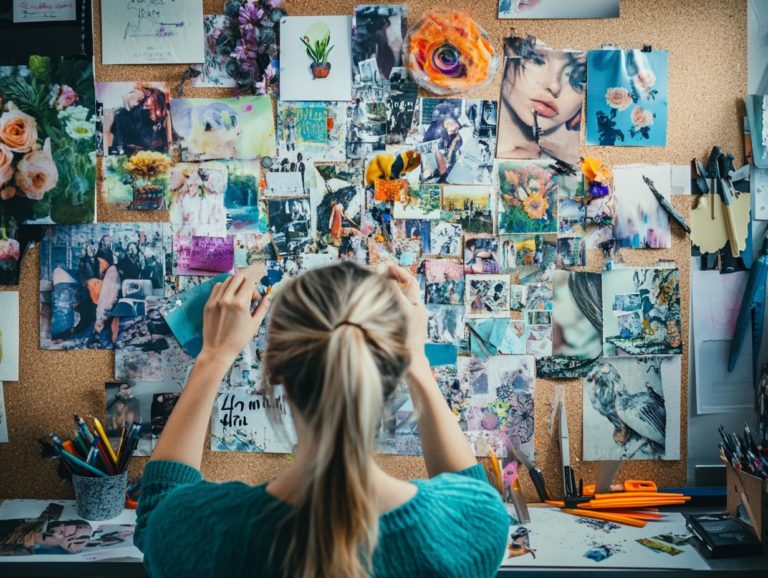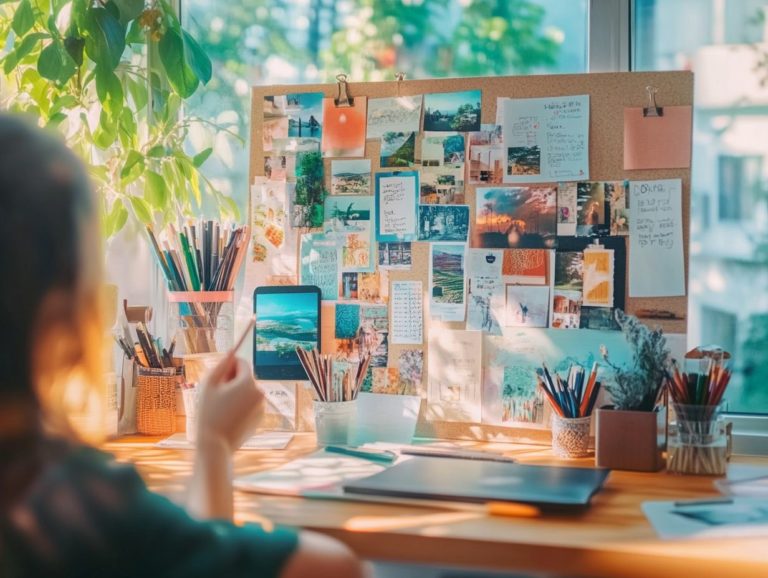Vision Boards in Therapy: A New Approach
Vision boards are remarkable tools in therapeutic settings, providing a creative avenue to visualize goals and dreams.
This article explores the transformative benefits of using vision boards in therapy. They enhance visualization, goal setting, communication, and self-expression.
You’ll find a step-by-step guide on incorporating vision boards into therapeutic practices, accompanied by inspiring case studies and a discussion of potential challenges along with effective solutions.
Discover how this innovative approach can empower your journey to well-being!
Contents
Key Takeaways:
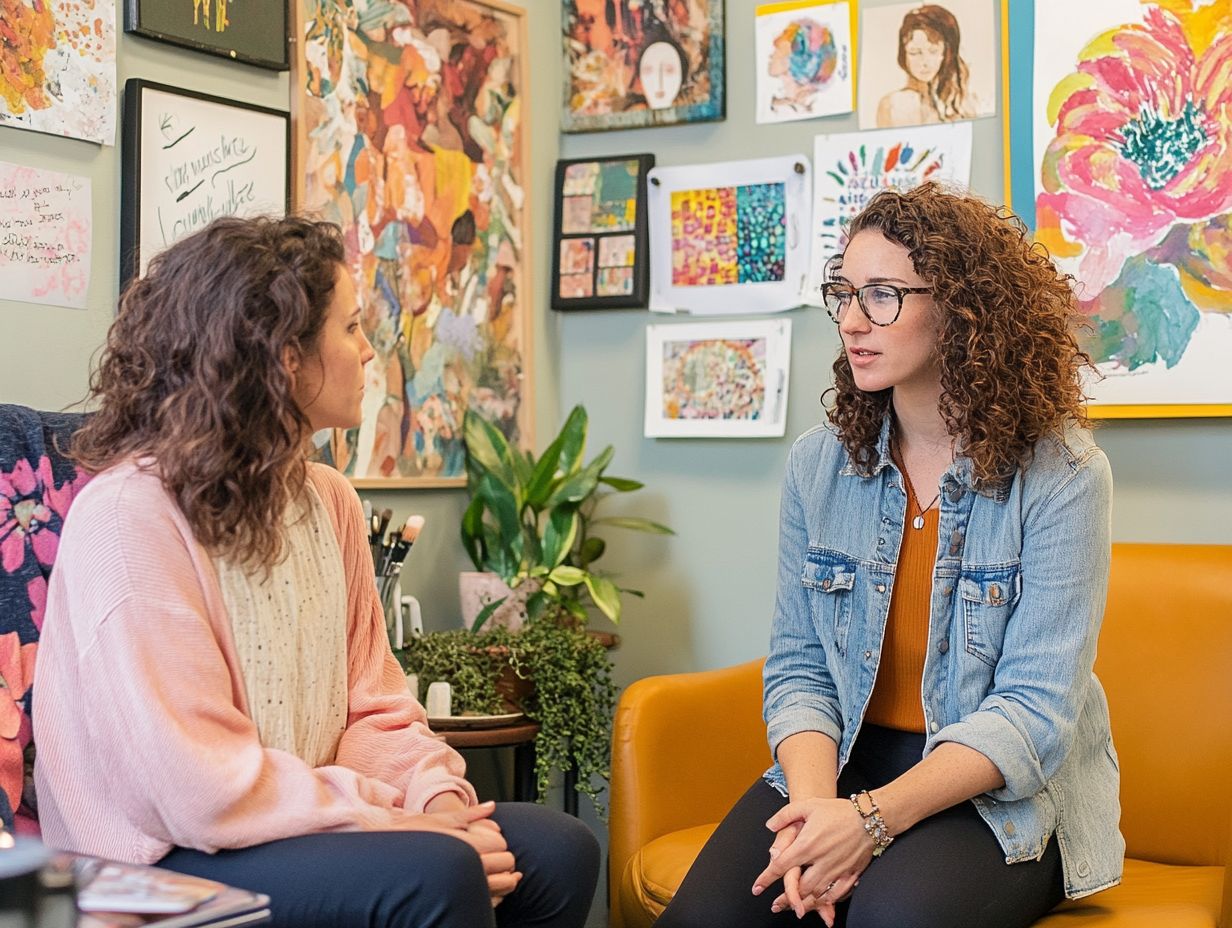
- Vision boards are powerful tools in therapy, enhancing visualization and goal setting while improving communication and expression.
- Incorporating vision boards in therapy provides a tangible and creative outlet for clients to explore their thoughts and emotions.
- Real-life examples showcase the benefits of using vision boards, but it s essential to address challenges such as resistance and limitations.
What are Vision Boards?
Vision boards are transformative tools that help you articulate and manifest your dreams. By creating a collage of images that reflect your goals, aspirations, and personal values, you foster deeper self-awareness and enhance emotional well-being.
This visual representation serves as a constant reminder of the future you desire, motivating you toward your goals.
Integrating visualization techniques with art therapy offers a tangible pathway to success and clarity while nurturing a positive outlook on what lies ahead.
The roots of vision boards trace back to early self-help practices, where visualizing desired outcomes was seen as crucial to achievement. They bridge intention and action, enabling you to engage actively with your subconscious mind.
By incorporating images, words, and symbols that resonate with you, you tap into your creative energies and explore your personal narrative. This ongoing journey aids in self-discovery and reinforces your sense of purpose, significantly enhancing mental health outcomes.
In this context, art therapy plays a vital role. Engaging in creative expression through vision boards allows for emotional exploration, leading to deep insights and transformation in your life.
Benefits of Using Vision Boards in Therapy
Using vision boards in therapy offers numerous benefits, including enhanced emotional well-being, deeper self-reflection, and effective goal setting.
By integrating creative expression, vision boards act as environmental cues that reinforce therapeutic concepts and spark meaningful discussions between you and your therapist. This approach resonates with strategies advocated by experts like Ekua Hagan and Lyubomirsky, highlighting the role of visualization in achieving personal values and motivating goals.
Enhancing Visualization and Goal Setting
Vision boards significantly enhance your visualization techniques and goal-setting efforts. They allow you to craft a vivid representation of your aspirations. This approach promotes personal growth by transforming abstract desires into tangible, actionable steps, guiding you toward success in various aspects of your life.
By engaging in therapeutic art, you can delve into your emotions and help you understand better your goals. This fosters clarity regarding your personal values and what truly motivates you.
The process of building a vision board is a transformative experience that encourages self-reflection and sparks creativity. You actively curate images and words that resonate with your dreams, reinforcing a clearer path toward your objectives.
This exciting visualization technique boosts your motivation and nurtures a positive mindset, effectively reducing the anxiety that often accompanies unmet goals. These boards serve as daily reminders of your aspirations, cultivating resilience and commitment.
Psychological studies reveal that visualizing your goals can stimulate the connections in your brain related to achieving your goals, enhancing your emotional well-being and propelling you toward personal fulfillment.
Improving Communication and Expression
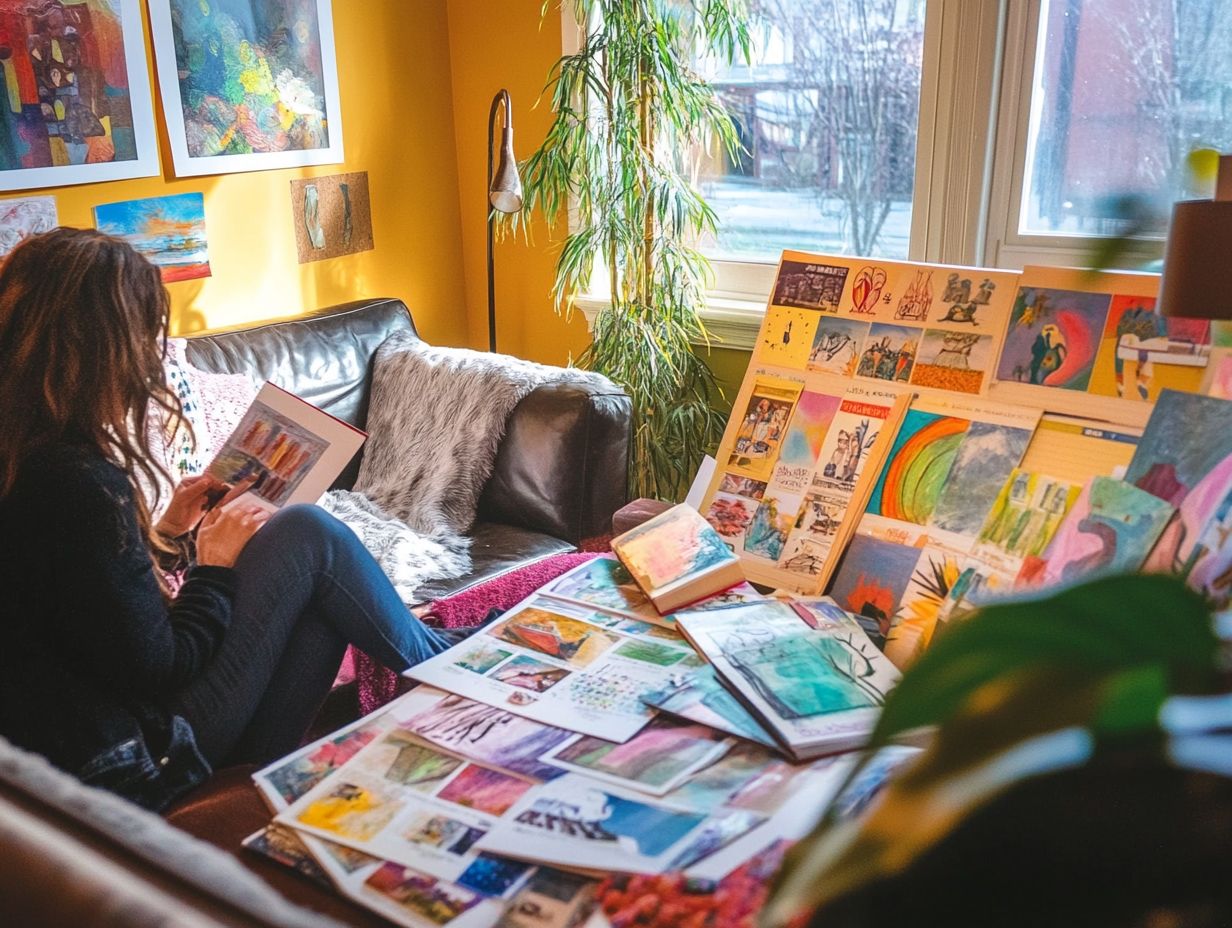
The use of vision boards in therapeutic settings can significantly enhance your communication and expression. They allow you to articulate your feelings and aspirations with greater clarity. By visually representing your thoughts and goals, you foster deeper connections with your therapist, elevating your emotional well-being and self-awareness.
This dynamic promotes a healthier therapeutic relationship and enables you to express your needs and desires through a compelling visual medium.
These visual tools act as a bridge between your internal emotions and external expressions. They guide you through complex feelings that might otherwise remain unspoken. As you engage with images and symbols that resonate with your experiences, you cultivate a heightened sense of self-awareness that leads to more meaningful conversations.
When you frame your narrative through curated visuals, it enriches your understanding of yourself and strengthens your ability to connect with others. This newfound clarity aids in resolving conflicts and nurturing empathy, ultimately enhancing your interpersonal communication skills and emotional expression across various relationships.
How to Incorporate Vision Boards in Therapy
Incorporating vision boards into therapy can be a transformative process. It enables you to express your aspirations visually. This approach is highly customizable, catering to your individual needs. It serves as an effective self-care tool that enhances your personal values and fosters emotional regulation.
By engaging in discussions about your goals and dreams, your therapist can guide you in crafting vision boards that resonate with your unique journey toward success.
Step-by-Step Guide
Creating a vision board is a transformative journey you can approach step by step. This emphasizes action-oriented creativity and personal expression. This method invites you to engage deeply with your aspirations while cultivating self-awareness and motivation as you work toward manifesting your dreams. By adhering to structured guidelines, you can craft a personalized vision board that truly reflects your unique goals and emotional well-being.
To get started, gather your materials: poster boards, magazines, scissors, glue, and markers. These tools will serve as your canvas for creative expression. Next, take a moment to reflect on your dreams and aspirations. Identify themes that resonate with you on a deeper level, whether they pertain to career ambitions, travel desires, or areas of personal growth.
Once you ve clarified those themes, dive into the fun part: selecting images and words that capture these visions. Embrace a playful attitude when choosing symbols and visuals, as this can enhance your emotional connection and ignite creativity. As you assemble everything onto the board, view it as an artful expression of your journey. Infuse it with feelings of hope and positivity as you visualize your path forward.
Start creating your vision board today to see quicker results!
Case Studies and Success Stories
Case studies and success stories featuring individuals who have utilized vision boards in therapy offer compelling evidence of their effectiveness in promoting personal growth and emotional healing. These amazing stories show how vision boards can help clients achieve their dreams! Through dedicated self-reflection and steps you can take to reach your goals, clients can turn aspirations into reality.
Real-Life Examples of Vision Boards in Therapy
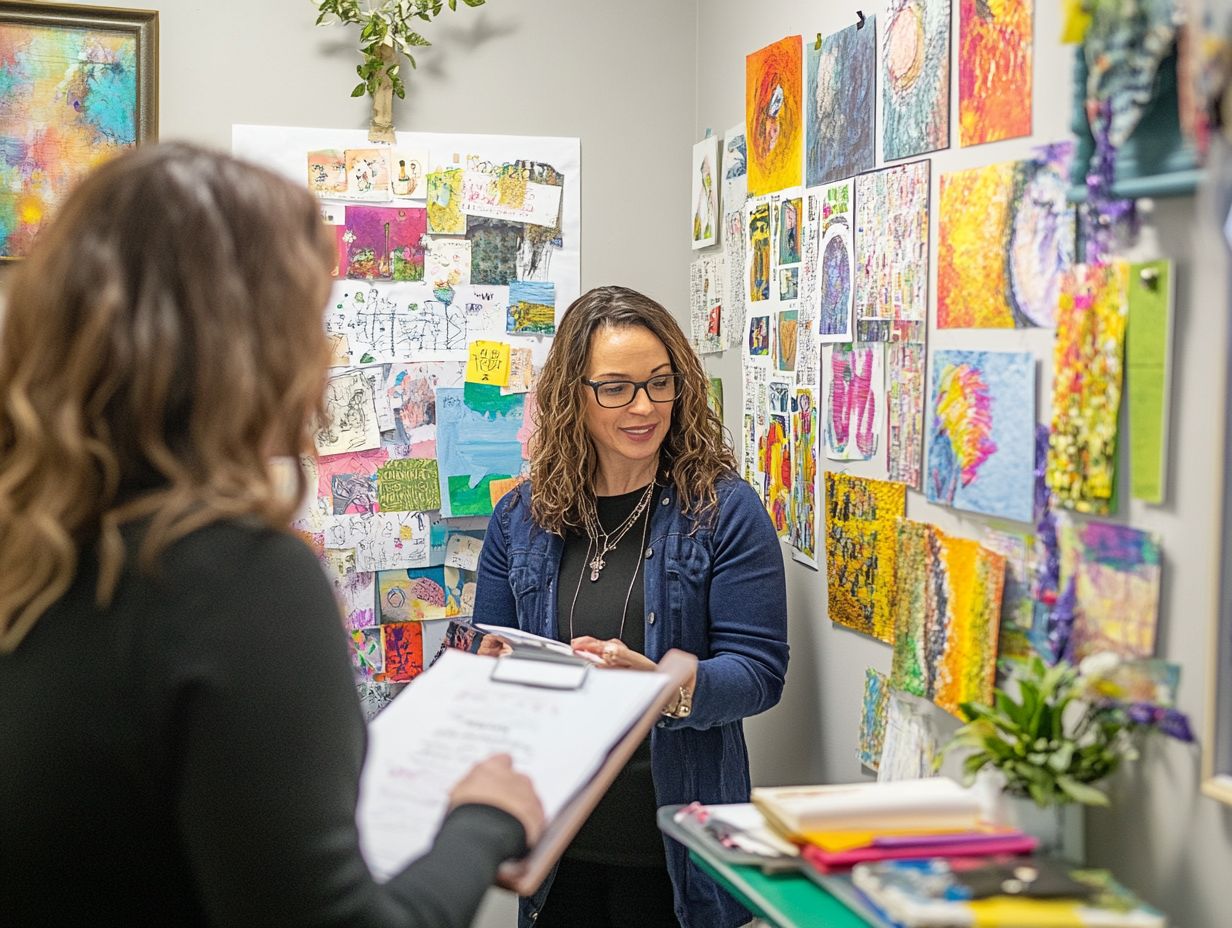
Real-life examples of vision boards in therapy reveal the many ways you can harness this powerful tool to enhance your emotional well-being and align with your personal values. These stories highlight the transformative power of visualization and creative expression, showcasing how vision boards can act as catalysts for change and personal development in therapeutic settings.
For instance, imagine a group of adolescents collaborating with a counselor. They introduce vision boards to explore their aspirations and challenges. Each participant crafts a board adorned with images and words that embody their dreams everything from educational ambitions to emotional healing.
As they witness each other’s reflections, a sense of community and support grows, making them feel truly seen and understood. One participant shares newfound clarity about her future, while another feels more enabled to tackle personal struggles.
These experiences not only boost their self-esteem but also provide a tangible reminder of their goals, reinforcing their commitment to growth.
Potential Challenges and Solutions
While vision boards can serve as powerful tools in therapy, you may encounter certain challenges and limitations. It’s essential to address potential resistance from clients and navigate the emotional barriers that can arise. These are crucial aspects of successfully implementing vision boards in the therapeutic process.
By acknowledging these hurdles and crafting strategic solutions, you can foster resilience.
Addressing Resistance and Limitations
Addressing resistance and limitations when using vision boards in therapy requires a nuanced understanding of emotional regulation and mindfulness techniques, which are methods to stay aware of your feelings and surroundings. You might find that self-doubt or fear of vulnerability initially holds you back. However, with the right support and encouragement, you can learn to navigate these barriers.
Effective strategies help you overcome these challenges and cultivate a positive mindset towards your personal growth.
One key approach is to dive into mindfulness exercises that help you connect with your emotions before you start creating a vision board. Engaging in grounding techniques, such as deep breathing or guided imagery, can enhance your self-awareness and alleviate anxiety.
By collaborating with your therapist to set realistic, measurable objectives, you can gain a sense of enablement as you witness your progress. This transforms the vision board into a tangible tool on your therapeutic journey.
Encouraging regular reflections on your vision board can also promote emotional regulation. As you articulate your feelings and aspirations, you ll deepen your understanding of your motivations, facilitating a stronger commitment to change.
Frequently Asked Questions
What is a vision board?
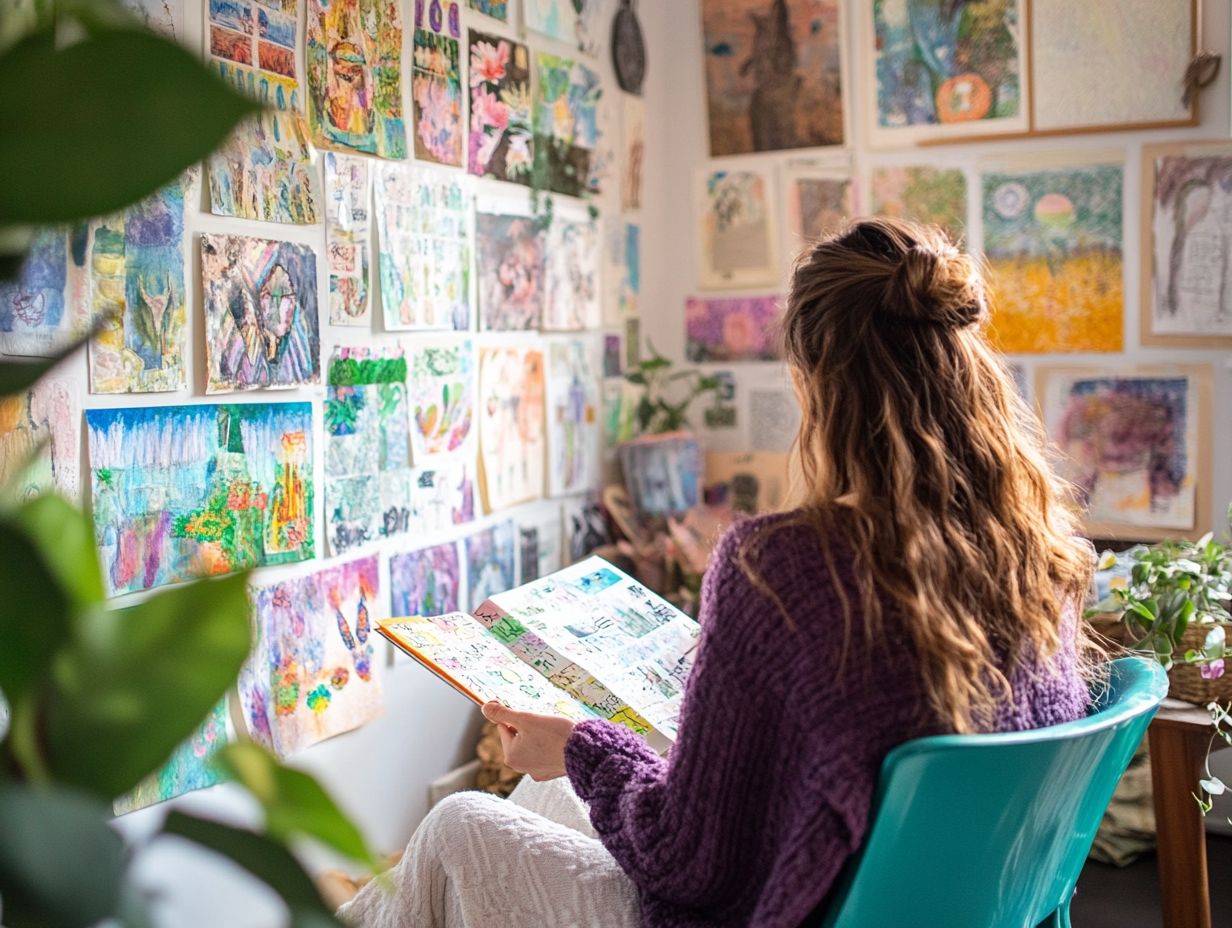
A vision board is a visual representation of your goals, dreams, and desires. It is a collection of images, words, and quotes that represent what you want to manifest in your life.
How can vision boards be used in therapy?
Vision boards can be used in therapy as a tool for self-discovery and goal-setting. They help individuals identify their desires, clarify their values, and create a roadmap for achieving their goals.
What makes vision boards unique in therapy?
Vision boards use visualization and creative expression to enhance therapy. They help you explore your inner desires and motivations.
Who benefits from vision boards in therapy?
Anyone can benefit from vision boards! They’re helpful for people facing anxiety, depression, trauma, and even those seeking clarity in life.
What do you need to create a vision board?
You don t need any special skills or materials. Just grab a board or canvas, some magazines, scissors, glue, and let your imagination run wild!
Can vision boards support long-term personal growth?
Yes! Vision boards remind you of your goals and keep you focused. Update them as your aspirations change over time.
Start your journey to personal growth today!




